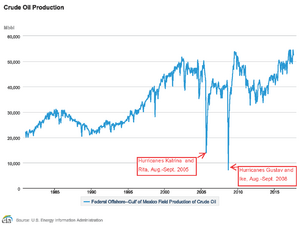Offshore oil and gas in the Gulf of Mexico (United States) facts for kids
Offshore oil and natural gas in the Gulf of Mexico are super important sources of energy for the United States. The western and central parts of the Gulf, which are off the coasts of Texas, Louisiana, Mississippi, and Alabama, produce a lot of the oil in the U.S. In 2017, oil production from federal waters in the Gulf of Mexico hit a record high of 1.65 million barrels every day! Experts think this will keep growing because new oil fields are starting up. The Energy Information Administration says that oil from the Gulf of Mexico makes up about 17% of all U.S. crude oil production, and natural gas from the Gulf makes up 5% of the total U.S. production.
Some of the big oil fields in the Gulf include Eugene Island block 330 oil field, Atlantis Oil Field, and the Tiber oilfield. There are also famous oil platforms like Baldpate, Bullwinkle, Mad Dog, Magnolia, Mars, Petronius, and Thunder Horse.
Contents
How Oil Drilling Changed Over Time
Over the years, oil companies have gotten much better at drilling for oil. They've moved farther from shore and into much deeper water. Back in 1937, one company built a platform just over a mile from shore in water only about 13 feet deep. A year later, another company built a long wooden bridge into the sea to place a drilling rig, but a hurricane later destroyed it.
It was a big deal when platforms were first installed in 100 feet of water in 1955, then 200 feet in 1962, and 1,000 feet in 1979! By 2009, more than 70% of the oil from the Gulf of Mexico came from wells drilled in water deeper than 1,000 feet. This shows how much technology has improved. The deepest oil discovery ever made in the Gulf was in water almost 10,000 feet deep!
The U.S. government has not allowed drilling in the eastern Gulf of Mexico (off Florida and part of Alabama) since 1995. In 2010, President Barack Obama first planned to allow some drilling there, but after a big oil spill, his administration stopped those plans. They put a hold on new drilling in the eastern Gulf for at least seven years. In 2016, new rules were put in place to make offshore drilling safer.
The Deepwater Horizon Event
The Deepwater Horizon oil spill happened on April 20, 2010, in the Gulf of Mexico. It was on an oil rig operated by BP. This event tragically killed eleven people. It is known as the largest marine oil spill in the history of the oil industry. The spill was so big that it led to new rules and efforts to improve safety for offshore drilling.
How Much Oil and Gas is Produced?
In 2012, federal leases in the Gulf of Mexico produced 463 million barrels of oil. This was about 19.5% of all U.S. oil production that year. It was more oil than any U.S. state produced, except for Texas. Even though 2012 production was a bit less than in 2009, experts believe that oil production from the Gulf of Mexico will increase again because of new discoveries in deep water.
Oil and Gas in Different States
Each state along the Gulf Coast has its own history with offshore oil and gas.
- Louisiana: This state issued its first offshore oil and gas lease in 1936. The very next year, the first offshore oil field in Louisiana was found. It was about 1.2 miles from shore in shallow water. Today, there are more than 4,000 oil platforms and drilling rigs off the coast of Louisiana.
- Texas: The first offshore well in Texas was drilled in 1938, but oil wasn't found until 1941. Through 2007, Texas state waters had produced 39 million barrels of oil and 4.0 trillion cubic feet of natural gas.
- Alabama: The first oil test in offshore Alabama was in Mobile Bay in 1951. The first discovery in Alabama's state waters was made in 1979. By 2005, production in Alabama's state waters provided 154 billion cubic feet of natural gas each year, which was half of the state's total gas production.
- Florida: The eastern Gulf of Mexico, off the coast of Florida, has never been a big area for oil and gas production. From the 1950s to the 1990s, oil companies drilled exploratory wells there, but most were "dry holes" (meaning no oil or gas was found). Florida has also banned offshore drilling in its state waters since 1992 and has often opposed more drilling in federal waters near its coast.
What are Natural Gas Hydrates?
Natural gas hydrates are like ice but contain natural gas trapped inside. They have been known to exist in the sediments (like mud and sand) beneath the Gulf of Mexico for a long time. In 2009, the United States Geological Survey announced they found thick deposits of these natural gas hydrates that could potentially be recovered using today's technology. However, natural gas from these hydrates has not yet been produced from the Gulf of Mexico.



